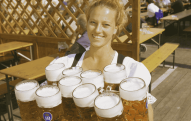Can we influence the evolution of an idea...
Read part 1 of this series at:
http://www.themunicheye.com/news/The-yin-and-yang-of-social-interaction-3211
Can you imagine an exclusive social circle with a qualification-based filter in the interest of blossoming and evolving ideas?
If so, how would such a group function?
It would be akin to birds of a feather flocking together and as a result would preclude contact with people from different social settings.
Naturally, exchange of ideas between such distinct separated groups would become improbable if not impossible.
On the contrary, if we move towards an inclusive society where all individuals are treated equal, would social interactions be helpful or detrimental?
Centola remarks, "For decades, managers have been taught that creating networks that "span" organizations can increase knowledge diffusion. The results from my study show that this strategy can sometimes backfire. In other words, increasing the span of people's business networks to increase the spread of knowledge across organizations can sometimes result in less-effective knowledge sharing. My findings identify the importance of having network ties within working groups or departments to reinforce the adoption of new practices, and the solutions to hard problems. "
In other words, the current results suggest that unfettered inclusion simply dilutes the positive effects of the interaction.
In van de Rijt's opinion, the past study of Centola has refuted the so called "disease model" of social behavior.
"The terms "viral" and "contagious" are commonly used in the context of marketing and online social networks. In this classic view, a single relationship is sufficient to spread a behavior from one place or group to the next," comments van de Rijt.
However, does behavior spread the same way? Is it enough to have a single link or connection to achieve an integration of ideas among different levels of the society?
"Centola showed us that many behaviors that are critical to the healthy functioning of a society or organization -- the adoption of a new technology, or organizational practice, or participation in grass-roots mobilization -- unlike diseases do not spread unless individuals are "infected" from multiple sources. Networks that are effective at spreading social behaviors, he reasoned, and demonstrated, must contain what he called "wide bridges": Multiple cross-cutting ties from one group of people to another, providing a robust conduit for transmission," says van de Rijt.
Therefore, what does it take for the efficient evolution of an idea?
Centola's study advocates finding a sweet spot for creating group boundaries.
The study reveals that finding a middle ground is vital, such that the right amount of a group boundary makes it fairly easy to achieve rapid integration of ideas across the whole network.
As Centola points out, "The results from my study highlight the value of "brokering groups." Within an organization, brokering groups are composed of people who have ties to several different ties to different departments, and also have strong ties with one another. These groups can provide important social continuity across teams, divisions, or workgroups, which can thereby facilitate the effective translation and transmission of new practices."
But how do we measure the success of the trend, (referred to as a measure of "social diffusion" by Centola)?
Let us look at a case scenario where a woman decides to try out a new fashion accessory in her office.
Other women who notice her like it and decide to replicate that.
This idea now percolates into the other groups of people that each of the women interacts with, and thereby a fashion trend emerges, spreading like wildfire.
The success is measured by Centola as a fraction of people in the population that adopt this trend.
As mentioned earlier, unlike the spread of an epidemic disease, which mostly requires contact only with one affected individual, it turns out that social norms and cultural practices require a much more complex interaction pattern in order to be diffused.
So where do we go from here? How can we apply what we have learnt from this study?
A very interesting and a similar study published last year by van de Rijt, reported on a series of experiments in which the researchers tested the "success-breeds-success" hypothesis.
van de Rijt states, "In one experiment we sampled new projects posted on the well-known crowd funding website Kickstarter.com and made either 0, 1, or 4 donations to these projects, deciding randomly as to how many donations each project received. We found that three weeks later when these projects hit their fundraising deadline, the ones we had made no donations to had raised on average $103 dollars. Those that we had given 1 donation to had raised about $294 in follow-up donations from third parties. The projects we gave 4 donations to had received an average of about $562 of follow-up donations from third parties."
Therefore, what does all this imply?
As van de Rijt points out, both these studies confirm that several individuals are motivated to engage in a social behavior only when several others have preceded them.
In short, crowdsourcing is here to stay.
In the words of Marie von Ebner-Eschenbach, the Austrian writer who said it best, "If you have one good idea, people will lend you twenty". And that is a good thing!
Â
Image credit: http://holykaw.alltop.com/how-to-boost-your-network-with-social-media



































